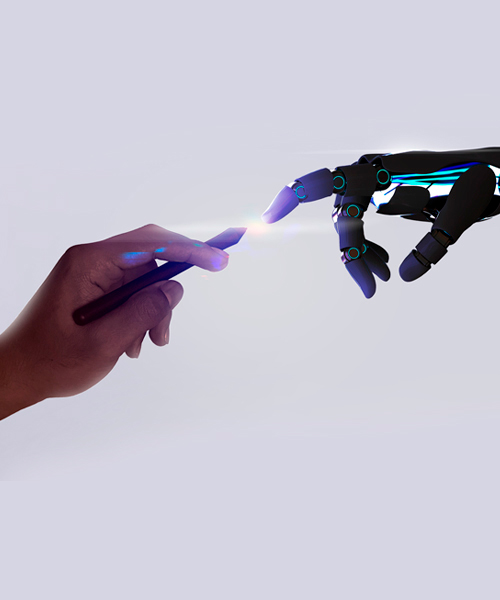Natural language processing
Natural language processing
Words connecting worlds
Words connecting worlds
Natural language processing (NLP) is a constantly evolving technology that is transforming the way we interact with machines and the world around us.
An everyday example of NLP is the autocorrector on our cell phone. When we write a text message, this technology analyzes the words we type and suggests corrections for spelling or grammatical errors. This process, which seems so simple, is actually a complex application of natural language processing, involving morphological, syntactic, and semantic analysis of language.
What is natural language processing (NLP)?
What is natural language processing (NLP)?
NLP is a branch of Artificial Intelligence (AI) that enables computers to understand and process human language. In essence, it acts as a translator bridging the gap between the language that people use and the language that machines are capable of interpreting.
Evolution of natural language processing
Evolution of natural language processing
This technology has evolved considerably since the 1950s, thanks to theoretical progress, technological changes, and access to large amounts of data.
Throughout history, it has gone through several stages:
- 1950s-1960s, rules and patterns: In this early phase, natural language processing systems used predefined linguistic rules to parse language. Programmers had to manually create a large number of rules so that the computer could understand human language.
- 1970s-1980s, statistical approaches: Computers became more powerful, allowing researchers to use statistics to analyze large amounts of text. In this way, they could discover patterns in language and create more robust systems that would adapt to different types of texts.
- 1980s-1990s, the rise of computational linguistics: Grammars and the first machine translation systems were created, laying the foundations for modern machine translation. Progress was also made in the development of question answering systems and chatbots.
- 1990s-2000s, the web and big data: In this period, the internet grew exponentially, which generated a vast amount of information in text form. NLP systems could now access and process text in real time, which greatly expanded their capabilities.
- 2000s-2010s, probabilistic models and machine learning: Probabilistic models were developed, enabling tasks such as text classification and entity extraction. Machine learning was consolidated as a fundamental tool for natural language processing, facilitating the training of models from large amounts of data.
- From 2010 to the present, deep learning and neural networks: Deep Learning, Machine Learning, and Generative Artificial Intelligence (GAI) have revolutionized NLP. These technologies enable computers to learn from large amounts of data, such as text and conversations, to perform complex tasks with greater accuracy and fluency.
How natural language processing or NLP works
NLP combines computer language with machine learning and Artificial Intelligence to process human language in a similar way to how we as humans do it.
- Morphological analysis: the text is broken down into words, assigning these words information about their grammatical category (noun, verb, adjective, etc.) and their meaning.
- Syntactic analysis: the structure of sentences is analyzed to determine the relationships between words and how meaning is constructed at the sentence level.
- Semantic analysis: the meaning of words and sentences in the context of the text is determined. For this purpose, techniques such as lexical semantics are used.
- Pragmatic analysis: it goes beyond the literal meaning, it analyzes the context of the text. In this way, the author's intention and the full meaning of the message can be understood.
NLP applications
NLP applications
NLP is present in many areas of everyday life, even if we are not always aware of it. This technology is transforming the way we interact with machines, allowing us to communicate in a more natural and intuitive way.
Some examples of natural language that we use in our everyday lives are:
- Automatic translation: enables instantaneous translation of texts from one language to another.
- Text summary: independently generates summaries of long texts.
- Text generation: automatically creates texts, such as news or emails.
- Voice assistant: understands questions and answers them naturally.
- Customer service: integrated into software, it enables natural interaction with users to answer frequently asked questions and solve problems.
- Accessibility: improved access to information for people with visual or hearing impairments.
- Search engines: uses natural language processing to understand user queries and deliver relevant results in search engines such as Google or Bing.
- Social networks: detects inappropriate content and selects customized posts for each user.
- Banking: analyzes transactions and detects possible fraud.
- Hospitals: studies patients' medical histories and helps diagnose possible illnesses.
Join Repsol: your talent makes the difference
We are looking for profiles with skills in different technological areas. Discover the latest current openings.
NLP tools
NLP tools
There are now many tools that use natural language processing algorithms to simplify our lives. Some everyday examples are:
- Siri: Apple's virtual assistant captures the user's voice, processes the information, and responds immediately using audio. It is used to make calls, send messages, set alarms, and much more.
- Alexa: this device developed by Amazon works in a similar way to Siri. It captures the user's voice and provides instant responses. It is used to play music, control smart devices, and obtain information on weather, traffic, or news.
- Google Translate: a free instant translation tool, offering immediate translation in more than 100 languages.
- Mobile AutoCorrector: corrects spelling and grammatical errors in texts written on mobile devices and computers.
- Streaming platforms: Netflix, Spotify, or YouTube use natural language processing to recommend personalized content to their users, facilitating the discovery of new movies, series, songs, or videos that fit their preferences.
Human talent: the engine that drives AI
Human talent: the engine that drives AI

Repsol Tech Lab, the hub of AI innovation within the company, is a space where experts from various disciplines work side by side to develop cutting-edge technological solutions. These include natural language processing, a constantly evolving field that opens up endless possibilities.
Our commitment to NLP is reflected in tangible projects, led by our highly specialized AI employees. These projects cover a wide range of applications, such as: the development of an intelligent chatbot for customer service, the creation of a system for analyzing customer opinions on social networks, and the automatic translation of technical documents into different languages.


